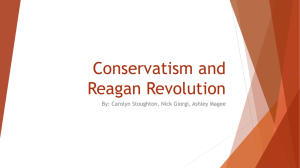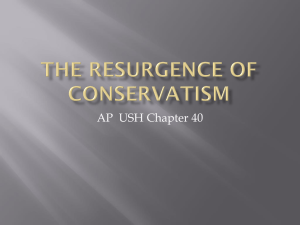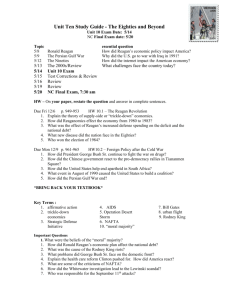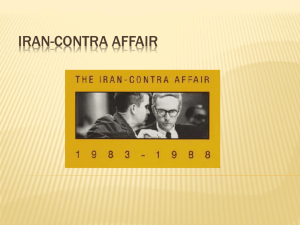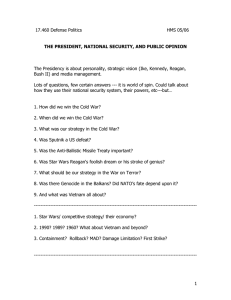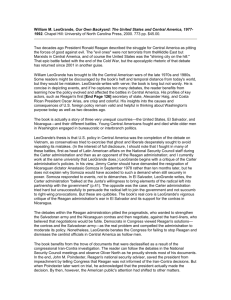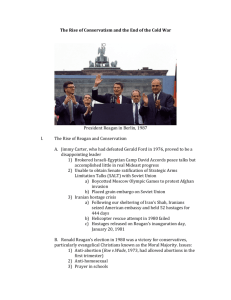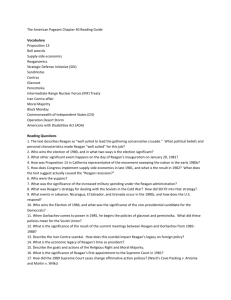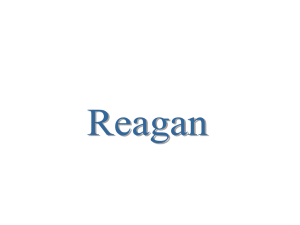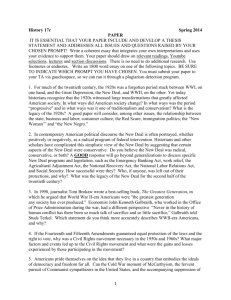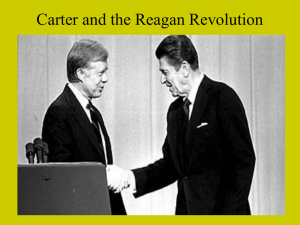The Reagan Years
advertisement
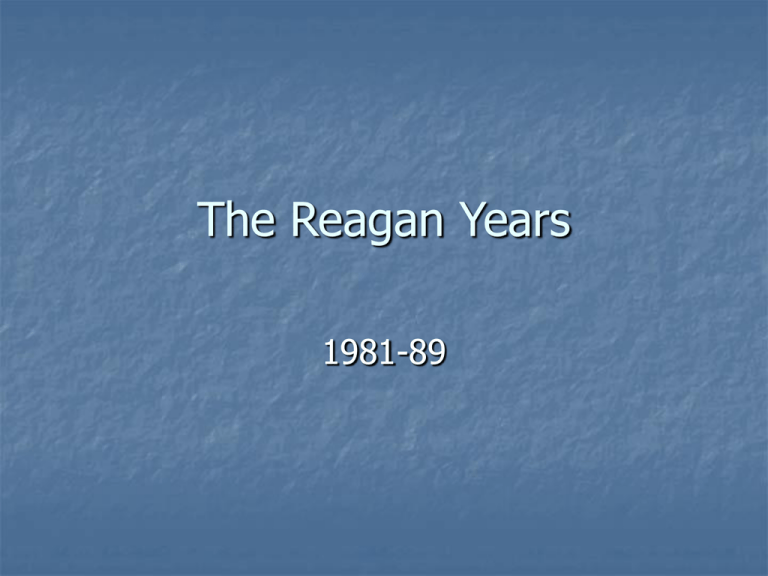
The Reagan Years 1981-89 Ronald Reagan: President, 1981-89 Casper Weinberger: Secretary of Defense, 1981-87 A harder stance towards the U.S.S.R. Reagan administration placed competition and possibility of war with Soviet Union at center of its defense & foreign policy. Pursued large build-up of U.S military forces Took a more active stance towards combating Communist insurgencies. Reagan Doctrine Called for helping anti-Communist movements around the globe. Examples: Nicaragua: aid for the contras (anti-Sandinista guerillas). Afghanistan: aid for mujaheddin tribesmen. Angola: aid for UNITA Increased defense spending Military budgets increased for six straight years (FY1980-85). Reagan Administration spent about $2.4 trillion. Defense budgets rose to $290-300 billion annually. Money spent on… Maintenance, training, and compensation. New weapons systems. B-1 bomber Trident II missile MX missile new ships Strategic Defense Initiative Announced March 1983. a/k/a “Star Wars” Sought to develop a system to destroy incoming missiles Other effects… 1980-86: U.S. national debt doubled. Debt service payments tripled. Waste & fraud in defense procurement reaches alarming levels. $400-$500 for a hammer? Arms control: Strategic Arms Reduction Talks (START) U.S.-U.S.S.R. negotiations from 1981-91. Almost produce an agreement during Reagan-Gorbachev meeting at Reykjavik, Iceland, 1986. Summit fails on issue of SDI START talks produce treaty in 1991 Reagan & NATO U.S.: Gets allies to continue deployment of Pershing II & GLCM’s, and to spend more for defense. Army and USAF get NATO to adopt “AirLand Battle” as common doctrine to for defeating a Warsaw Pact invasion. Allies: push U.S. on negotiations to reduce theater nuclear and conventional forces. December 1987: INF Treaty U.S. & U.S.S.R. agreed to eliminate all their intermediate-range (300-3,400 mile) ground-launched ballistic and cruise missiles. Included provisions for on-site inspections. All such missiles and related equipment destroyed by May 1991. U.S. involvement in Latin America El Salvador: American aid and advisors sent to help the government Fighting the Frente Martí Liberación Nacional (FMLN) since 1979. Nicaragua: Began helping groups opposed to the Sandinista regime (contras). October 1983: Grenada Soldiers from U.S. and Caribbean nations invade. Follows a coup Concern about expanding Cuban and Soviet influence. Anxiety regarding U.S. medical students. Problems in the Middle East Israel & Lebanon Muammar Gaddafi & terrorism The Persian Gulf 1982: Israel invades Lebanon Goal to drive out Palestinian groups. U.S. sent Marine expeditionary unit to help enforce a ceasefire. October 23: truck bomb blows up the Marine barracks 220 soldiers die, 241 total. Terrorist incidents on the rise Attacks & hijackings double, 1983-85. Led to 1,000 U.S. casualties Most famous incident: 1985 hijacking of the Achille Lauro After event, US Navy jets force down plane carrying hijackers to Tunisia. 1986: U.S.-Libyan tensions rise Naval incidents. West Berlin bombing tied to Gaddafi. Reagan orders bombing of Tripoli and Benghazi. Mostly military targets destroyed, 200 casualties. Problems in the Persian Gulf Iran: fundamentalist Islamic state, hostile to U.S. interests. Funding terrorist movements. Region large producer of oil. 1980-88: Iran-Iraq War Iraq received more foreign assistance, including official U.S. aid. Both sides attacked Gulf shipping. U.S. looks to Saudi Arabia as a regional ally. Saudis had influence over other Mid-East nations, and indirectly over Palestinians. supported mujaheddin in Afghanistan Spent money to buy American arms, and allowed U.S. to build bases on Saudi soil. Attacks on Gulf shipping rise. 1987-88: U.S. Navy deploys to Gulf and Red Sea to protect tanker shipping. Destroys Iranian gunboats and other vessels, missile sites, and attacks bases. Iran responds with mine laying. Worst U.S. goof: shooting down an Iranian airliner. U.S.S. Stark U.S. frigate fired upon by an Iraqi fighter. Resulted in 37 deaths. Second-term problems for the Reagan Administration Budget and debt issues. Congressional opposition. Lax oversight of subordinates leads to political crisis. Iran-Contra Affair Administration officials arrange secret arms sales to Iran, some proceeds diverted to contras. Hope to release hostages in Lebanon, influence Hezbollah. Violated U.S. law that prohibited arms sales to the contras, and Administration’s own stated policy not to negotiate with terrorists. Changes in the Soviet Union Mikhail Gorbachev: General Secretary of the Communist Party, 1985-91. Sought better relations with the West Pursued internal reforms (perestroїka, glasnost). Gorbachev: Foreign Policy Highlights 1986, meets with Reagan in Reykjavik, Iceland. Though fails in near term, ultimately leads to: INF Treaty, 1987 START Treaty, 1991 1988, announces U.S.S.R.: Will pull troops out of Afghanistan. Will allow Eastern bloc countries to determine affairs. Will unilaterally begin reducing conventional forces in Europe.
